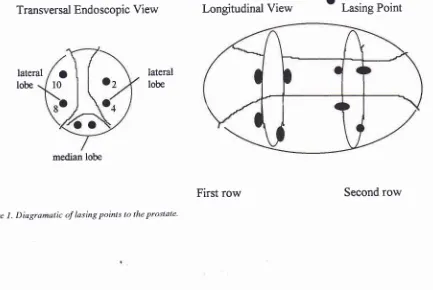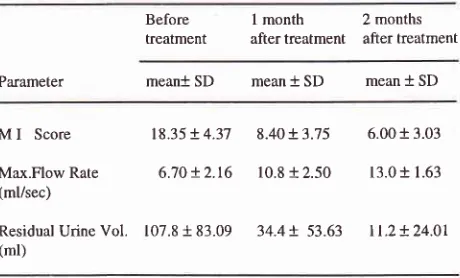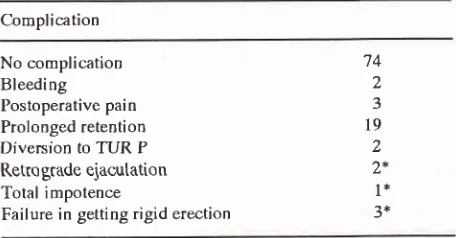Visual Laser
Ablation
of the Prostate
(VILAP): Experience of the
First
One
Hundred
Cases
in
Jakarta
Djoko
Rahardjo
Abstrak
Transurelhral resection
of
lhe prostate (TUR P) masih merupakan cara baku penanganan penderita dengan Pembesaran Prostat Jinak (PPJ), meskipun masih banyak kampliknsi yang dapat terjadi. Visual laser ablation of the prostate (VILAP) menggunakan NeodymiumYttriumAluminum Garnet (Nd.-YAG) laser mulai diperkenalkan sebagai alternatif penanggulangan PPJ pada manusia pada tahun 1992. SejakApril
1993 sampai Mei 1994 di RS Sumber Waras, Jakarta, d.ilakukan WI,AP pada 100 penderita dengan PPJ. Rata-rata umur penderita 67.8 tahun dengan kisaran 47 - 91 tahun. Dari 700 pendeita pada 85 penderita dapat diperoleh d.ata yangIengkap untuk evaluasi. Rata-rata skor Madsen lversen membaik
dari
18.3 menjadi 8.4 dan 6.0 masing-masing setelah 7 dan 2 bulan (p<0.05) sedang rata-rata pancaran maksimal naik dari 6.7 mlldetik menjadi 10.8 nlld.etik dan 13 mlldetik (p<0.05) dan sisa kencing turun dari 107.8 ml menjadi 34.4 dan 11.2 nl 1 bulan dan 2 bulan setel.ah operasi (p<0.05). Terjadi komplikasi perdarahan pada 2 penderita yang tidak memerlukan transfusi d.arah d,an nyeri pada 3 penderita. Retensi lebih dari 1 minggu pada 19 penderita dan pada 2 penderita terpaksa dilakukan TUR P. Ejahtlasi retrograd ditemukan pada 2 penderita dari 74 penderita yang masih peduli terhadapkehidupan seks. Impotensi pada
I
penderita dan kcgagalan mencapai kekakuan (rigiditas) pada waktu ereksi pada 3 penderita.Abstract
Transurethral resection of the prostate (IUR P) is still regarded as a standard treatment for BPH, but still have complication.Visual laser ablation of the prostate
(VIL
P) usingNeod.ymiumYttriumAluminum Garnet laser has been introduced as an alternativetrealmenl for BPH since 1992. We have treated 700 cases of BPH by VII,AP since April 1993 îill May 1994 in Sumber Waras Hospital. Mean ageof the patients is 67.8 years range 41-91 years. From the 700 palients, only in 85 patients was the data obtained enough
for
analysis. There were improvement of mean symptom score (Mad,sen lversen)from
18.3 initially to 8.4 and 6.0 after 7 month and 2 months respectively (p<0.05) and, mean maximal flow rate increased from 6.7 ml/second to 10.8 ml/second andlj
ml/second after 1 month and 2 months respectively (p<0.05) while rest urine dropped from 107.8 ml initially to 34.4 ml and 11.2 ml1 month and 2 months respectively (p<0.05). Complications : Post operativè bleeding occured in2 patients but no blood transfusionwas required, post operative painwere found. in 3 cases and. prolonged retention (more than one week) in 79 cases and in two cases TUR P were done. From 74 cases who are still concern with sex, retrograde ejaculation were found in 2 cases, impotence in one case and in 3 cases failure to havefull
rigidity were noticed.Keywords : Visual laser ablation of the prostate, benign prostatic hyperplnsia, efficacy, complication.
INTRODUCTION
Benign
ProstateHyperplasia (BPH)
is the secondmost
frequent
disease
in
uiological
clinic
in
Indonesia.l
Nearly
6O7o ofthe time
of
practicing urologist
isfocused
on this
disease.'
The incidence
of
BPH
isrelated
to age,
where
at
the
ageof
60 years the
in-cidence is about
5O7o and around onethird of
it
needs treatment.3-7Transurethral
Resectionof
the Prostate(TUR
P) isstill
regarded as a standard of treatmentwith
its advantagesas a fast relieve from obstructive
symptoms,
giving
tissue for pathological
specimen,but
at the sametime
it
also has many disadvantages such astime consuming
operation, bleedingwhich may
needblood transfusion,
clot
retention,
possible
hiponatremia, retrograde
ejaculation,
i mpotence i n abouI 4-4OEo.3'6'8-
1Therefore in
theselast
10 yearsmany other alternative
methods
of
treatment
for
BPH
have been
proposed.Medical treatment has been
tried, and
5
reductaseinhibitor
toprevent further enlargement of
the gland isstill
under
investigation,"'"
and
1adrenergic
block-Division of tJrology, Deparhnent of Surgery, Facultyof
ing
agentto
release bladderneck functional
obstruc-tlon in
useful
only for
temporary
treatment.13-15Less invasive treatment such as
balloon dilatation,
andurethral
stenting
tlte
results are
only
temporary
relief
of
obstruction.r0'r
/
Hyperthermia
and thermotherapy
sives
onlv i*p.ou"rnËnt of
the obstructionin
5O-607oËf
th"
"ur"r.t8
Neodyrnium Yttriurn Aluminutn
Gameet
(Nd YAG)
laser was tried to ablate prostategland for the first time
iri
1991.
It
was Roth and Aretzre who tried
prostateprostate
lnore
accurately. Since laser beam
gives
coagulation
necrosis
and
notvisual
laserablatioq of
the Prosminimal
bleeding.2o Because nspecirnen
can be
obtained
by VILAP,
preoperative assessrneutto exclude rnalignancy is
becoming very
.21.22
unponanr.
To our
knowledge,
until
now
there was no report yet
on
the experience
in
using
VILAP
in
Indonesia, our
first experience
in treating
100 cases of BPH byVILAP
will
be reported.MATERIALS
AND METHODS
Frorn
April
1 993until May
1994, 100 patientswith
thediagnosis
of
BPH
have been
treated
by
VILAP
in
238 Rahardjo
lateral
lobe
Transversal Endoscopic
View
Longitudinal
View
Med J Indones
Sumber Waras
Hospital,
Jakarta, usingNd YAG
laserfrom
TRIMEDYNE
generator,with Myriad
sidefiring
laser
fiber, with
adiameter
of
600micron.
The inclusion criteria were
patientswith
the diagnosisof
BPH, signing informed consent
for
laser treatment,with
Madsen Iversen
symptom
score
more than
10,maximal
flow
rate less than 10ml/second measured by
Dantec Flowmeter,
or
residual
urine volume
of
morethan 50
ml
measuredby
post
voiding
catheterization,
no suspicionof
malignancy on
digital
rectal
examina-tion (DRE)
andon suprapubic ultrasonograpy,
serum prostate specific antigen(PSA) level
less than 4ngltnl,
negative
urine culture
and no bladder stone detected byintraveuous urogprahy
(IVU)
and cystoscopy.Exclusion criteria were urinary tract infectiott,
signs andclinical
symptoms
of
neurological
bladder
disor-ders, urethral stricture, bladder stone aud
bladder
diverticulurn.
Treatrneut was perfonned
by
using GU cystoscope
ru
22
Charier sheath
to
introduce the laser fiber, with
destilled water
as anirrigating fluid.
Lasing was
doneat
lO, 2,4,
and8 of endoscopic
view,
60 seconds at 60watts at
eachpoint
of
lateral lobes, and
if
the prostaticurethra
is
more than 2.5 cm
in
length,
two
rows of
lasing
points
with
the same methodwere done
respec-tively,
andfor
rnedianlobe
two
or three lasing points,
dependon the size
of
the rnedian
lobe,
30 seconds
at60 watts were done (see
Figure
1).Suprapubic
tubedwelling
catheterusing Cystofix 12 Charier artd
in-using 20 Ch. Folley
catheter
wereo_
Lasmg Potnt
o
l0
lateral
lobe
[image:2.595.79.512.510.800.2]median lobe
Figure 1. Diagramatic of lasing points to tlxe proslale'
introduced post operatively. Indwelling
catheter
wasremoved three days post
operatively,
and suprapubictube
was
removed after
spontaneousmicturition
oc-curs.Preoperative
assessement
consists
of
physical
ex-amination,
including DRE,
measurement
of
Madsen
Iversen Symptom
score,maximal
flow
rate, postvoid-ing
residual
urine,
serum prostate speficic
antigen(PSA), intravenous urography
(IVU),
and suprapupbicultrasonography.
Postoperative
assessementwas
done one
month
andtwo
monts postoperatively,
measurementof
symptom
score,
maximal
flow
rate, post
voiding
residual urine
were performed,
andcomplications were
noted.Improvement
of
symptom
score,
maximal
flow
rate,and residual
urine volume
were analyzed bycomparing
their
mean values, preoperative and postoperatively,
using
student
t test,
and
p <
0.05
is
considered
assignificant.
RESULTS
From
100 patients treated byVILAP,
the mean age twas67.8
years (range
4l
To9l
years).
The
laser
energyapplied
between
14.4to
32.6
kilo joules.
The
energywas calculated
by multiplying
thenumber
of
secondsto
thenumber
of
watt
usedduring
the treatment.Table
l.
Age distribution of patients treated by VILAP.Age
(Years) No of patients4t-51
51 - 60
61-70
71-80
81-90
9t
The preoperative mean
of
symptom score
was
18.35with
standarddeviation
of
4.37,
the meanof
maximal
flow
ratewas 6.62 ml/sec.
with
standarddeviation
of
2.16 mllsec, and the mean of residual urine
volume
was 107.8ml
with
standarddeviation
of
83.09ml.
After
onemonth
andtwo
monthsfollow-up,
only
in
85cases
the
data
of
symptom
score,
maximal
flow
rateand
residual urine volume could be
obtained.
In
10 casesthey
refusedcatheterization to
measureresidual
urine,
andin 5
cases we lost offollow-up.
Only
in thosecases
with
complete data theimprovement of symptom
score,
maximal
flow
rate, and residual
urine
volume
were
analyzed.From the 85 cases, the mean
of symptom
score that wasinitially
18.3with
standarddeviation
of 4.37preopera-tively,
decreasedto
8.4with
standarddeviation
of
3.75 after one monthfollow-up
(p<0.05)
and 6.0with
stand-ard deviation
of
3.03 after
two
months (p<0.05). The
score
after two
months
follow-up
consists
mostly
of
irritable
symptoms. Meanmaximal
flow
rate increasedfrom
6.7ml/sec
with
standarddeviation
of
2.16 ml/secinitially to
10.8with
standarddeviation
of 250
ml/secafter
onemonth (p<0.05) and
13ml/sec
with
standarddeviation
of
1.63
ml/sec after two months
(p<0.05),
while
mean residual urine volume
decreased
from
107.8
ml with
standarddeviation
of
83.09m1initially
to
34.4
ml
with
standarddeviation
of
53.63
ml
after
one
month
(p<0:05)
andlI.2
ml
with
standard [image:3.595.292.522.417.556.2]devia-tion of
24.01ml
after
two
months (p<0.05).
Table 2. Results
of
VILAP
using Nd YAG forBPH
in
85 evaluable cases.Before treatment
I
month
2 months after treatment after treatmentParameter meant SD mean
* SD
meant
SDM
I
ScoreMax.Flow Rate
(ml/sec)
Residual Urine Vol. (ml)
18.35 +
4.37
8.40 +3.75
6.00 + 3.036.'t0 +
2.t6
10.8 +2.50
13.01 1.63t07.8 +
83.09
34.4!.53.63
tt.2+24.01 222 38 29
8
I
100
For all
the three
parameters,the
improvement of
onemonth
and
two
month after treatment were
all
sig-nificant
(p<0.05).
Complications
Bleeding
was observedin
two cases,in
one of the caseswe
had to coagulate the bleeding
point using cutting
loop,
andin
theother
one thebleeding
wasovercome
by putting
traction
to the balloon inflated
Folley
[image:3.595.29.262.493.613.2]240 Rahardjo
Postoperative
pain was
observed
in
three
cases, andketoprofen
100mg Suppository tdd for two
days weregiven.
Prolonged
urinary retention (more
than seven
days)were observed
in
19 cases,and the longest was
until
11 days.
Diversion
to
TUR
Poccurs
in
2 cases,in
oneit
was becauseof
the median lobe was not intendedly
choppedduring
the lasing process, and the freefloating
of
median lobe obstructed, and
TUR
was performed.
In the second case,TUR
P was done because thepatient
came
from
a remote area, and he wanted to be freefrom
suprapubic tube
as soon aspossible.
No postoperative true incontinence
was observed.Only
in
74
casesin
our
series
who
still
had concernwith
sexuallife,
from which
retrograde ejaculation was observedin
2 caseswith
the ageof
65 and 51 yearsold,
total
impotence
in
1
case(patient
had beensuffering
from
diabetessince
10 years)with74
yearsof
age, andfailure in having
full rigidity
during
erectionin
3 cases,which
preoperatively they
never had thatproblem.
Table 3. Adverse effects of VILAP in 100 patients with BPH
Complication
Med J Indones
From
those 85 caseswith
evaluable
data, we observedsignificant improvements
in
the mean
of
symptom
score,
which
decreasefrom
18.3initially
to 8.4 and 6.0,one month and
two month respectively;
meanmaximal
flow
ratewhich
increased
from
6.7 ml/sec
initially
to
10.8ml/sec and
13.0ml/sec,
andmean residual urine
volume
decreasedfrom
107.8
ml initially to
34.4
ml
and
ll.2
rnl
one and
two months respectively.
This
findings
arecomparable
with
the result
of
Costello
etal.8'e
The
improvements
of all
parameters
were
ob-servedvery clearly during
thefirst
onemonth, but
still
continuing
until two
months after treatment (p<0.05),
this findings are
consistent
with
the
finding
of
his-tological
"hung",
as reported
by
Costello23
thut th"
process
of
coagulation necrosis and tissue sloughing
still
occureafter
onemonth or lnore.
In
our
series, gross hematuria
was found
in
2
cases(27o)
which is
much
lessthan the result
of
Cowles
etal.za ç1.6.17o),^but
higher
if
compared
to
the result
of
Kabalin
et
al.z5which claiming no
changesin
hema-tocrit
and no requirement
of
blood
by Kabalin
et
a1.26 andNaraj
pain was
observed
in
three
cases(3%) which also
less
than the
series
of
Cowles
(17.7%f4
andin
thosethree
casesthey
needketo-profen
1 00mgsuppository.
Prolonged
retention
(more than seven days) was
ob-served
in
19
cases(1970)
which
in
two
cases werelasting
until
11 days, andin two
cases(2%)
diversion
to
TUR
Pshould
be done becausein
one case,part
of
medianlobe
was chopped and the treefloating
median
lobe obstructed the bladder neck, and rernoved byTUR
after
resectedin
tosmaller
pieces, andin
theother
one case becauseofpractical
reason to free thepatient
from
cystostomy
as soon aspossible
since thepatient
cornefrom
remote area.This
nurnberof
diversion
toTUR
Pis smaller
than the seriesof
Cowles
et
a1.24Which
hefound
four
casesout
of
56.The prolonged retention rate
in
our
series
(19%)
islower
compared to the lasercoagulation therapy group
(25%)
but
higher than the evaporation therapy group
(6.250/o) reported
by
Narajanet
al."'
in
hisconperative
study.
Retrograde ejaculation was noted
in two
casesout of
74 who
still
have concern
on
sexual
life,
arrdunfor-tunately
those
two
casesbelongs
to the
younger
agegroup,
55 and59
yearsold, this finding
isbetter
thanNo complication Bleeding
Postoperative pain Prolonged retention Diversion to TUR P Retro grade ejacutation Total impotence
Failure in getting rigid erection
74 2
J
l9
2
2*
1*
J'
+ amongst 74 patients who still have concerns on sexual life
DISCUSSION
VILAP
is
still
relatively
a newmethod of
treatmentof
BPH. As far
aswe know,
nosingle study
onthis
newtechniques
hasbeen reported
in
Indonesia. Therefore
we think
it
is
necessaryto report our
results
in
using
VILAP
for
the treatment
of BPH
as afirst
experiencein
Indonesia.
We were
still
using
MadsenIversen
scoring systemfor
syrnptoms, since most
of
our
cases consistsof
elderly
people
with
not sohigh educational level, which
rnake [image:4.595.62.290.396.515.2]the
result
reported
bv
Cowles
et
a1.24 andKabalin
et al.2s'26wnicn
is
Kio
attwelve
months
of follow-up,
and 277oafter
three yearsof follow-up.
Total impotence after
VILAP
was noted
in
one
74years
old patient who
has beensuffering frorn
diabetesmellitus
since the
last
10 years.In
this
case,we
think
that the
cause
of
total
impotence
is
not only by
theVILAP.
In
three
cases,
failure
in
having
full
rigidity
during
erection
was
observed
two
months
after
VILAP
andthe age
of
thepatients were
55,56 and 77 yearsrespec-tively.
It
is
very
difficult
to
correlate the failure
of
erection
to
the ageof
thepatient.
This failure of
erec-tion
rate
is hisher
ethan the
seriesof
Kabalin
et
a1.264<
and
Narajan
etal.'"
which they clairn
no impotencein
his
series-,but lower
than theresult
of
Cowles
et
a1.24CONCLUSIONS
In
our
experience,
the
treatment
by
VILAP
for
BPH
patients
in
our
first
100
cases,using Nd
YAG
laserresulted
significant
improvement
in
mean
MadsenIversen
symptom
score,
rneanmaximal flow
rate andmean
residual
urine
volume, one month and two
months
after
theprocedure.
Ttwo
months post-treatment,
the meansymptom
scoreis
still
6.0,but mostly
consistsof irritative
symptoms.The
adverse
effects
of
VILAP in
our
series
is
com-parable
with
other investigators.
Base on our
first
experience,furtherstudy
onlong term
result
of VILAP
should
be done toknow
thedurability
of
theresult
which
it
isvery
important
if
wewill
offer
VILAP
as analternative to
TUR
P.From the previous
different
investigators,
we
found
that
TUR
Pgives more
morbidity
anà mortality3'6'8-10compared
to our short-term
follow-up of VILAP.
REFERBNCES
1. Iskandar S, Rinald, Subagja IG, Rahardjo D. Populasi kasus
bedah urologi
di
RSCM (Paper). Jakarta:
University ofIndonesia, 1990.
2. Vanden Bossche M, Noel JC, Schulman CC. Transurethral hyperthermia lor benign prostatic hypertrophy. Worl J. Urol.
l99l;9:2-6.
3. Christensen MM, Bruskewitz RC. Clinical manifestation of
BPH and indication
of
therapeutic intervention.
Urol.Clin.North Am. 1990; l7:509.
4. Ekman. BPH epidemiology and risk factors. The prostate supplement. Alan R., Liss Inc.1989; 2:23-31.
5.
Mc
NealJ.
Patbologyof
BPH. Insight
into
etiology.Urol.Clin.North.Am. 1990; l7 :477.
6. Rahardjo D. Pembesaran Prostat Jinak (Beberapa perkem-bangan cara pengobatan). Ropanasuri. 1993; 12:71-7 7. Schroder FH,
Blow JHM.
Natural historyof
BPH. Theprostate supplement. AIan R.Liss Inc. 1989; 2:17-22. 8. Costello AJ, Johnson DE, Bolton DM. Nd YAG laser
abla-tion of the prostate as a treatment for BPH. l-aser in surgery and medicine. 1992; 12:
l2I-4.
9. Costello AJ, Bosker WG, Bolton DM, Brasklis KG, Bent J.
Laser ablation
of
the
prostatein
patientswith
BPH.Br.J.Urol. 1992; 69 :603-8.
10. Orandi A. TUR P vs Transurethral incision of the prostate. Urol.Clin.North Am. 1990; 17: 601.
11. De Voogt HJ, Soloway MS. Prostate cancer. Emphasis on new treatment modalities. Hoechst medical update, 1985; 9:39-41.
12. Isaac JT, Coffey S. Etiology and disease process of BPH. Ttre prostate supplement. Alan R. Liss Inc. 1989; 2:33-50. 13. Caine M. Alpha adrenergic blocker forthe treatmentof BPH.
Urol.Clin.North Am. 1990; L7:64I.
14. Kawabe K, Moriyana N, Hamada K, Ishima T. Density and localization of alpha adreno receptors in hypertrophy pros-tate. J.Urol. l99O; 143:592-5
15. læpor H, Sphiro E. Characterization of alpha
I
adrenergic rec€ptorsin
human benign prostate hyperplasia. J.Urol. 1984; 132:1226-9.16. Dowd
JB,
Smith JJ. Balloon dilatationof
the prostate.Urol.Clin.North Am. 1990;
l7:67I.
17. NordlingJ, Poulsen AL. Prostatic stents; indications techni-ques and clinical result of prostaticcoil.In : FitzpatrickJM,
editor. Scciete Intemationale D'Urologie Reports. Non sur-gical treatment of BPH. New York: Churchill Livingstone. 1991; l5:145-53.
18. Lidner
A,Braf
Z, [-ev A, Golumb J, Lerg Z,Srege IY, et al. Local hyperthermia of the prostate gland for the treatment ofbenign prostatic hypertrophy and
urinary
retention.Br.J.Urol. 1990; 65:2OI-3.
19. Roth RA, Aretz TH. TULIP, Transurethral laser induced prostatectomy under laser guidance. J Urol. 1990; 143:285A.
20. Johnson EE, Price RE, Crommens DM. Pathologic changes accuring
in
the prostate following transurethral laser pros-tatectomy. Laser in surgery and medicine. 1992; 12:254-63. 21. Fehr JL, Knonagel H. lmportant of prostatic sonography in evaluation of conservative tberapy o[ prostatic hyperplasia. Urol.Int. 1990;45 :23 | -3.22. Paelang
BV.
Diagnostic assessmentof
BPH. The prostate supplement. Alan R.Liss, Inc. 1989; 2:51-68.23. Costello AI, Bolton DM, Ellis D, Crowe H. Histopathologi-cal changes in human prostaticadenoma lollowing Nd YAG
laser ablation therapy. J.Urol. 1994; 152:L526-9.
24. Cowles RS, Kaba li n JN, Chi I ds S. A prospecti ve ra ndomized compari sm of TUR to visual I aser abl ati on of the prostate
lor
the treatment of BPH. Urol.1995; 46:155-6O.
242
Rahardjo26.
Kabalin JN,
Bite G, Doll
S. Neodymium:YAG
lasercoagulation prostatectomy: 3 years of experience with277
patients. J Urol. 1996; 155: 181-5.
Med J Indones
27. Narayan P, Tewari A, Aboseif S, Evans C.
A
randomized

